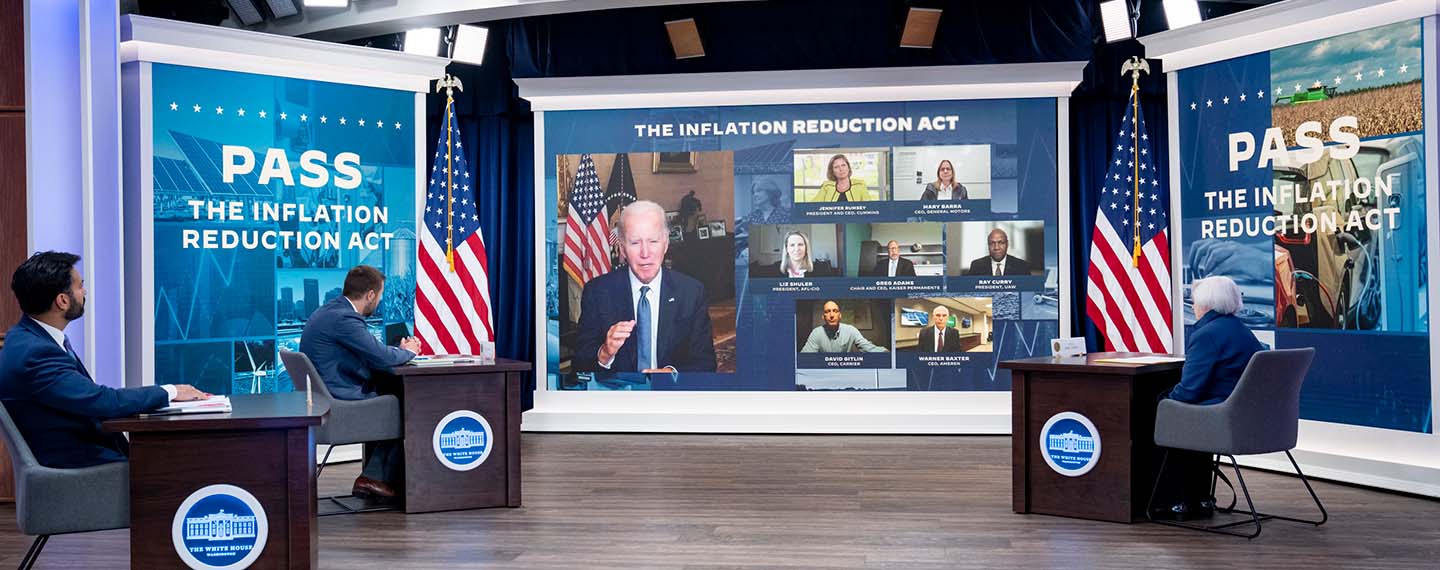Theme[1]
The Biden Administration’s new foreign economic policy strategy has implications for the transatlantic relationship.
Summary
This policy brief evaluates the current shift in US foreign economic policy thinking and highlights where the US and EU approaches align but also where they differ. While the US approach to trade and industrial policy centres on dual objectives –combating both climate change and China’s economic rise–, the EU has taken a more moderate approach that interweaves traditional trade policy with an evolving reassessment of geo-economic strategy. These differences have profound implications for transatlantic cooperation.
Analysis
The Biden Administration is pursuing a non-traditional approach to international economic engagement and trade policy. Coupled with this shift in thinking is the domestic pursuit of industrial policy via legislative packages like the Inflation Reduction Act (IRA) and the CHIPS & Science Act. This analysis evaluates the current shift in US thinking and highlights where the US and EU approaches align but also where they differ. While the US approach to trade and industrial policy centre around dual objectives –combating both climate change and China’s economic rise–, the EU has taken a more moderate approach that interweaves traditional trade policy with an evolving reassessment of geo-economic strategy.
Introduction
In the US, the Biden Administration is currently pursuing a non-traditional approach to international economic engagement, as underscored in recent speeches by the National Security Advisor, Jake Sullivan, and the Treasury Secretary, Janet Yellen. The overarching theme of the Administration’s approach to international economic engagement is twofold, based on: (1) the urgency of combating the climate emergency; and (2) the increased injection of national security concerns into international commercial considerations, both of which are evidenced in domestic packages with international implications, such as the IRA. This analysis will seek to answer a simple question: ‘so what does this all mean in the transatlantic context?’.
We first provide a short overview of the IRA and then assess key differences and commonalities in the US and European approaches to international economic engagement and climate change. Evaluating where the approaches overlap –and then where they diverge– sheds light on profound shifts currently underway in the global system and on the prospects for transatlantic cooperation.
An overview of the IRA
The IRA, signed into law in August 2022, aims to reduce carbon emissions through investments in domestic manufacturing, procurement of critical supplies and boosting research and development in leading green technologies. It is heralded as the largest single climate expenditure in US history, investing nearly US$370 billion into green economy sectors. The IRA is, along with the Infrastructure Investment and Jobs Act (IIJA) and the CHIPS & Science Act, one part of three pieces of legislation championed by the Biden Administration that inject major investments into the US economy. They total roughly US$800 billion in spending, equalling US$80 billion per year over the next decade.
The measures most relevant to the IRA’s international impact are its energy and climate subsidies.
The IRA alone is devoting US$369 billion in climate spending, through a combination of grants, tax incentives and loan guarantees. It has allocated US$95.6 billion to boost renewable energy resources and strengthening the hydrogen, solar and wind sectors. For instance, on hydrogen, the US is spending US$13 billion in tax credits.
The measures most relevant to the IRA’s international impact are its energy and climate subsidies. These fall into three categories: (1) subsidies for vehicle purchases, which includes the US$7,500 Electric Vehicle (EV) tax credit; (2) production and investment subsidies for manufacturers of clean-tech products, including batteries and components used in renewable electricity generation; and (3) subsidies for producers of carbon-neutral electricity, hydrogen and other ‘clean’ fuels. In addition, renewable energy producers are eligible for a ‘bonus’ subsidy linked to local content requirements.
Implementation of the IRA is unfolding slowly. Guidance about the interpretation of tax credits is trickling out, and the US Treasury Department announced more guidelines in March and April. The recent guidance provides additional information on implementation on the EV tax credit, such as the retail price of eligible vehicles, the location of final assembly, and the percentage of an EV battery’s critical minerals sourcing and processing. Nevertheless, many tax credits have yet to be defined fully. As a result, it is difficult to ascertain who will be the winners of the legislation.
The IRA’s impact on transatlantic trade has already been a significant topic of discussion. One of the main distinguishing characteristics of the legislation, for foreign partners, is its reliance on domestic incentives, which contrasts with the EU’s current approach to relax state-aid rules. In addition to its local content requirements, the US has also used the IRA to more clearly define its strategy, that attempts to encourage supply chains to move outside of ‘countries of concern’ –in this case, China–. While there was a clear attempt in Congress, which no doubt had support throughout the Administration, to on-shore parts of the supply chain, there was never any intention to ‘hoover up’ jobs from Europe during a geopolitically precarious time. This is evidenced in Senator Manchin’s remarks at Davos that he was unaware that the EU and the US did not have a trade agreement. Fundamentally, the package is a green jobs and anti-China package. It is also the only package that was politically feasible.
This, in turn, leads to another question: will the parties be able to achieve a critical-minerals deal that satisfies the IRA requirements so that European cars can benefit from IRA subsidies? The Biden Administration failed to seek Trade Promotion Authority, meaning every real trade agreement it pursues will need to be ratified by Congress. Because the EV tax credit language is so clear about benefitting partners of the US with an FTA, the Administration’s hands are tied: they cannot negotiate a ‘real’ agreement without congressional consent, but it must pursue critical-minerals deals to satisfy the demands of its close allies. How this plays out remains to be seen, but it highlights tensions at the nexus of climate, trade and security. It also underscores that these policies often come from the legislative branch and that the executive branch is left implementing and dealing with backlash from the packages.
Commonalities in the transatlantic context
Despite key differences, the US and the EU share several commonalities in their approach to international trade relations. First and foremost, both fundamentally believe in ‘de-risking’ versus decoupling when it comes to long-term trade relations with China. President von der Leyen outlined this in a recent speech on China. While the US may aim for strategic decoupling in a targeted set of national security critical sectors, both are inherently aligned in the belief that total decoupling is economically and politically unfeasible. They also both fundamentally believe in the power of incentives. The EU recently committed US$270 billion to combat climate change, versus US$369 billion in the US. While one set focuses on state-aid rule relaxation and another focuses on domestic-production incentives, they are both attempts to scale up and scale up fast.
Secondly, there is broad alignment between private-sector actors on both sides of the Atlantic. In short, companies want to conduct business in China but want to avoid scrutiny of ongoing business engagements there. The hot-button issue of China as a threat has made it politically unwinnable to support free trade as we know it, and this has had a chilling effect on good trade policy emanating from the US Congress. The hawkishness on China is unlikely to change, even with a change of Administration.
Another commonality, and one made potentially worse by the inability to pursue comprehensive trade deals, is that for both the EU and the US, costs will rise and efficiencies will decrease as governments and the private sector seek to ‘friend-shore’ and reshuffle supply chains, choosing resiliency and redundancy over the ‘just-in-time’ supply chains that had dominated the global economy before the pandemic. What remains to be seen is to what degree industrial policies in the EU and the US will succeed in offsetting some of these costs and whether or not the parties can cooperate sufficiently as to grow new transatlantic industries in advanced semiconductors or the clean tech of the future.
Another shared concern is the threat of export curbs on minerals and other inputs, whether from China or other third countries. As resources become increasingly scarce, countries may turn increasingly protectionist. While a total retraction is not possible, a reshuffle is already underway. A turn towards protectionism could exacerbate fragmentation and could lead to more consistent supply-chain disruptions, affecting a broad range of items such as solar panels, electric vehicles or everyday medication. It will fall on allied economies to ensure that they have contingency plans for further disruptions, whether caused by the climate crisis or a black swan event in the Taiwan Strait. Energy security is a key area where trade fragmentation and protectionism could have particularly adverse effects: the kind of price shocks and power-supply cuts we are seeing today can only scale up with more frequent supply-chain disturbances.
Transatlantic differences
The EU and the US continue to pursue different approaches to the intersection of international trade and climate change mitigation. The US is pursuing smaller, sectoral deals such as the Global Arrangement on Sustainable Steel and Aluminium, while the EU continues to affirm its commitments to the multilateral trading system and the WTO by pursuing a host of formal FTAs. The US remains committed to a largely incentives-based approach, while the EU focuses on a mix of regulatory and incentives-driven policies.
There are also major differences between the European and US approaches to geopolitics. The first is the degree to which each party views China as a problem. In the US there is a growing consensus that China is no longer its biggest customer, but its biggest threat. This is based on the assumption that Chinese power directly threatens US economic and national security. The US does maintain unhealthy dependencies on China. For instance, three quarters of EV battery production capacity depends on China and almost half of all US electronics imports come from China.
This differs from the EU, which continues to regard China primarily as a lucrative market for exports. German automakers, for example, derive a significant portion of their revenue from sales in China. While Europe may slowly be moving closer to the US stance on China, leading them to abandon the Comprehensive Agreement on Investment, which President von der Leyen confirmed during a recent speech, the EU is still less keen on entering a new chapter of geostrategic competition that pits the proverbial ‘West’ against the East. While a consensus emerges in the US on China, EU member states are still charting their paths.
The second major distinction in US-EU approaches is on whether economic security is a matter of national security. The US has recently pursued a set of agenda items, such as the 7 October export controls on AI chips to China, that highlight the blurring of economic and national security considerations. Furthermore, the controls were initially unilateral, denoting a scepticism among allies regarding the national security nature of the controls. That economic security is increasingly bleeding into national security is also clear in the IRA, which ties certain incentives to moving supply chains away from ‘countries of concern’, such as Russia, China, North Korea and others. The EU, on the other hand, tends to view security through a hard security lens, a belief that the unlawful Russian invasion of Ukraine has further enforced.
This, in turn, leads to another difference in the transatlantic approach to trade. Under the Biden Administration, the US government has increasingly pursued ‘friend-shoring’ –an agenda focused on deepening economic and trade relations with countries that do not pose an imminent security threat–. This leaves the US with the task of defining who is a ‘friend’ and who is not.
This ‘friend-shoring’ approach has manifested in the Administration shying away from traditional trade deals, eschewing market access provisions and tariff reductions for alternative economic arrangements –such as the US-EU Trade and Technology Council (TTC)–. Another non-traditional trade arrangement is the Indo-Pacific Economic Framework (IPEF), which the US is overseeing with 13 other countries, and its Latin American counterpart, the Americas Partnership for Economic Prosperity (APEP). These initiatives are characterised by their lack of market access concessions by the US and its tendency to shy away from tariff negotiations. Coupled with a skeletal corps of commercial diplomats, it is unclear how the US will conclude these arrangements and whether they will achieve the intended outcomes of reshuffling supply chains.
The EU, meanwhile, has continued to pursue FTAs and is poised to ratify the EU-Mercosur agreement in the coming months. The EU is also pursuing a hard-law approach when it comes to climate and trade, as indicated in its Carbon Border Adjustment Mechanism (CBAM), which applies tariffs at the border based on the carbon-intensity –or emission footprint– of certain imported commodities.
Another difference in the transatlantic trade and geopolitics agenda relates to the durability of the policies promulgated. In the US there are already efforts underway to tie debt ceiling negotiations to a repeal of various facets of the IRA. In the EU, trade and economic policies, such as the Digital Decade agenda, are often designed around five-to-10-year time horizons, providing a higher degree of immunity to electoral changes and a generally clearer roadmap about policy objectives.
Conclusions
The road ahead
In the absence of a formal doctrine, it can be tricky to see where the US is headed. In recent remarks, the National Security Advisor, Jake Sullivan, laid out what is to date the most detailed articulation of the Biden Administration’s strategy. In his speech, Sullivan argued that capitalism needs to look fundamentally different in order to confront today’s problems, saying that the traditional approach to trade was based on a set of ‘oversimplified assumptions’.
We are clearly entering a new chapter of world history. What this means for trade is not yet clear, but with new alliances emerge new opportunities.
To illustrate this point, Sullivan likened the transition to this new global vision as shifting from a Parthenon approach of the post-WWII era –a system characterised by neat columns and clean lines– to a future replete with Frank Gehry-style architecture, evoking Gehry’s overlapping ribbons of steel and aluminium that adorn buildings worldwide. This new economic order reflects a messier –but probably more accurate version– of how the world really works.
The speech called for patience and confidence in building a global vision, which Sullivan said would require ‘dedicated commitment’ among allied economies. Sullivan was generous with his support of the EU, clearly aligning itself with President von der Leyen’s bid to de-risk rather than decouple. This direct support for the EU is a not-so-subtle nudge for the bloc to continue inching closer to the US economic and security approach towards China.
The message is to trust the US, and the rest will come. This relies on a fundamental assumption that the Administration has sufficient time to ‘finish the job’, which may or may not be the case. With a ticking clock, it is unclear whether the Administration will see its non-traditional trade and economic agenda sufficiently take shape before the election. If it succeeds in winning another round, this could provide additional durability to its new agenda. Without another term, major threads of the agenda will unravel, adding uncertainty to trading partners and private sector entities alike.
Overall, it is clear that allied economies around the world must contend with a new multipolar reality. As the Secretary of State, Antony Blinken, said in a speech last October, the post-Cold War world order is coming to an end. We are clearly entering a new chapter of world history. What this means for trade is not yet clear, but with new alliances emerge new opportunities. Emerging technologies, green supply chains, and a fundamental de-risking of commercial ties does not need to mean less trade. Trade –and trade policy– will look different than in the past, but together we can shape the new reality.
[1] This analysis has been adapted from a May 2023 speech at the Naturgy Foundation in Madrid.



